

Extraction of Nematodes from Soil. Grasshoppers a byproduct of 2011 drought. Global Warming Shrinking Plant Leaves. Warming temperatures are turning a native Australian shrub into a mini version of itself, revealing the effect climate change is already having on the globe.
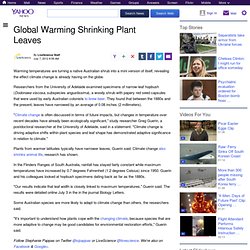
Researchers from the University of Adelaide examined specimens of narrow-leaf hopbush (Dodonaea viscosa, subspecies angustissima), a woody shrub with papery red seed capsules that were used by early Australian colonists to brew beer. They found that between the 1880s and the present, leaves have narrowed by an average of 0.08 inches (2 millimeters). "Climate change is often discussed in terms of future impacts, but changes in temperature over recent decades have already been ecologically significant," study researcher Greg Guerin, a postdoctoral researcher at the University of Adelaide, said in a statement.
"Climate change is driving adaptive shifts within plant species and leaf shape has demonstrated adaptive significance in relation to climate. " WeedWatchList. InsectWatchList. Kansas Department of Agriculture. Galapagos' new star tortoise does what Lonesome George didn't: Helps save his species. QUITO, Ecuador - Lonesome George's inability to reproduce made him a global symbol of efforts to halt the disappearance of species.

And while his kind died with him, that doesn't mean the famed giant tortoise leaves no heir apparent. The Galapagos Islands have another centenarian who fills a shell pretty well. Black Widow Spiders May Have Met Their Match. Black widow spiders seem to be universally feared.
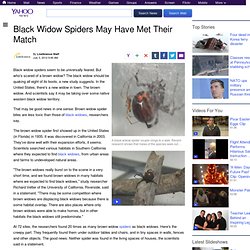
But who's scared of a brown widow? The black widow should be quaking all eight of its boots, a new study suggests. In the United States, there's a new widow in town. The brown widow. And scientists say it may be taking over some native western black widow territory. Crow goes tubing on rooftop. [VIDEO] - StumbleUpon. Galapagos 3D Movie Tickets & Trailer. Release Date: October 27, 1999.

PreloaderStemCells. Download the On-line Taxonomic Key. Tiny earthworms’ big impact. Invasive earthworms, like the ones in this bait cup sold at stores, are spread by human activity such as fishermen dumping live bait and gardeners using live compost worms near forests.

When invasive earthworms enter a healthy hardwood forest (top photo, Wisconsin) they change the ecosystem and eventually destroy the understory plants that native species depend upon (bottom photo, Minnesota). Top: Paul Ojanen; Bottom: UMD-NRRI Shown in blue are the areas of North America covered by glaciers 11,000 to 14,000 years ago. Most of the area of glaciation was earthworm-free until European settlers introduced earthworms in the 1600s. Great Lakes Worm Watch Invasive earthworms introduced to northern North America hundreds of years ago by European colonists have have changed the region's foests. What are the different branches of biology.
The scope of biology is enormous - it's the history of all living organisms and their role on earth.
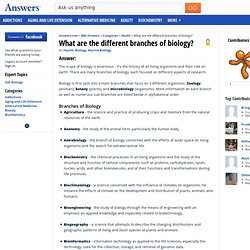
There are many branches of biology, each focused on different aspects of research. Biology is first split into 3 main branches that focus on 3 different organisms: Zoology (animals), botany (plants), and microbiology (organisms). More information on each branch as well as numerous sub-branches are listed below in alphabetical order. Branches of Biology Agriculture - the science and practice of producing crops and livestock from the natural resources of the earth.
How to Extract DNA from Anything Living - StumbleUpon. First, you need to find something that contains DNA.
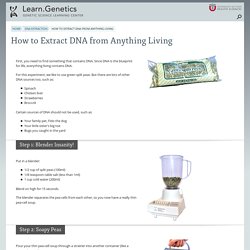
Since DNA is the blueprint for life, everything living contains DNA. Labeling Exercises. Cloning scientists create human brain cells. Scientist Ian Wilmut with Dolly, the worlds first cloned sheep, at the Roslin Institute near Edinburgh in 2001.
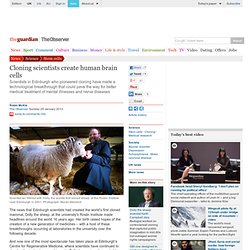
Photograph: Murdo Macleod The news that Edinburgh scientists had created the world's first cloned mammal, Dolly the sheep, at the university's Roslin Institute made headlines around the world 16 years ago. Her birth raised hopes of the creation of a new generation of medicines – with a host of these breakthroughs occurring at laboratories in the university over the following decade. And now one of the most spectacular has taken place at Edinburgh's Centre for Regenerative Medicine, where scientists have continued to develop the technology used to make Dolly. In a series of remarkable experiments, they have created brain tissue from patients suffering from schizophrenia, bipolar depression and other mental illnesses.
Professor Loses Weight on Twinkie Diet. Mark Haub, professor of human nutrition at Kansas State University, ate a Twinkie every three hours for ten weeks in an attempt to prove that caloric intake, rather than the healthiness of food, was the main factor contributing to weight loss, to which I reply, “Duh.”
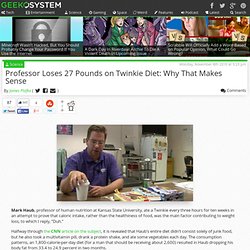
Halfway through the CNN article on the subject, it is revealed that Haub’s entire diet didn’t consist solely of junk food, but he also took a multivitamin pill, drank a protein shake, and ate some vegetables each day. The consumption patterns, an 1,800-calorie-per-day diet (for a man that should be receiving about 2,600) resulted in Haub dropping his body fat from 33.4 to 24.9 percent in two months. His other health markers improved as well, including his bad cholesterol dropping 20 percent and his good cholesterol rising 20 percent. “When you lose weight, regardless of how you’re doing it — even if it’s with packaged foods, generally you will see these markers improve when weight loss has improved.”
Cell Biology Lesson Plans.